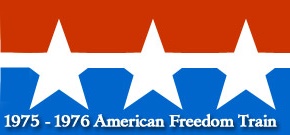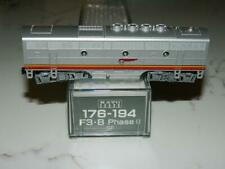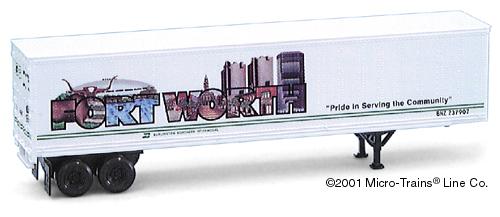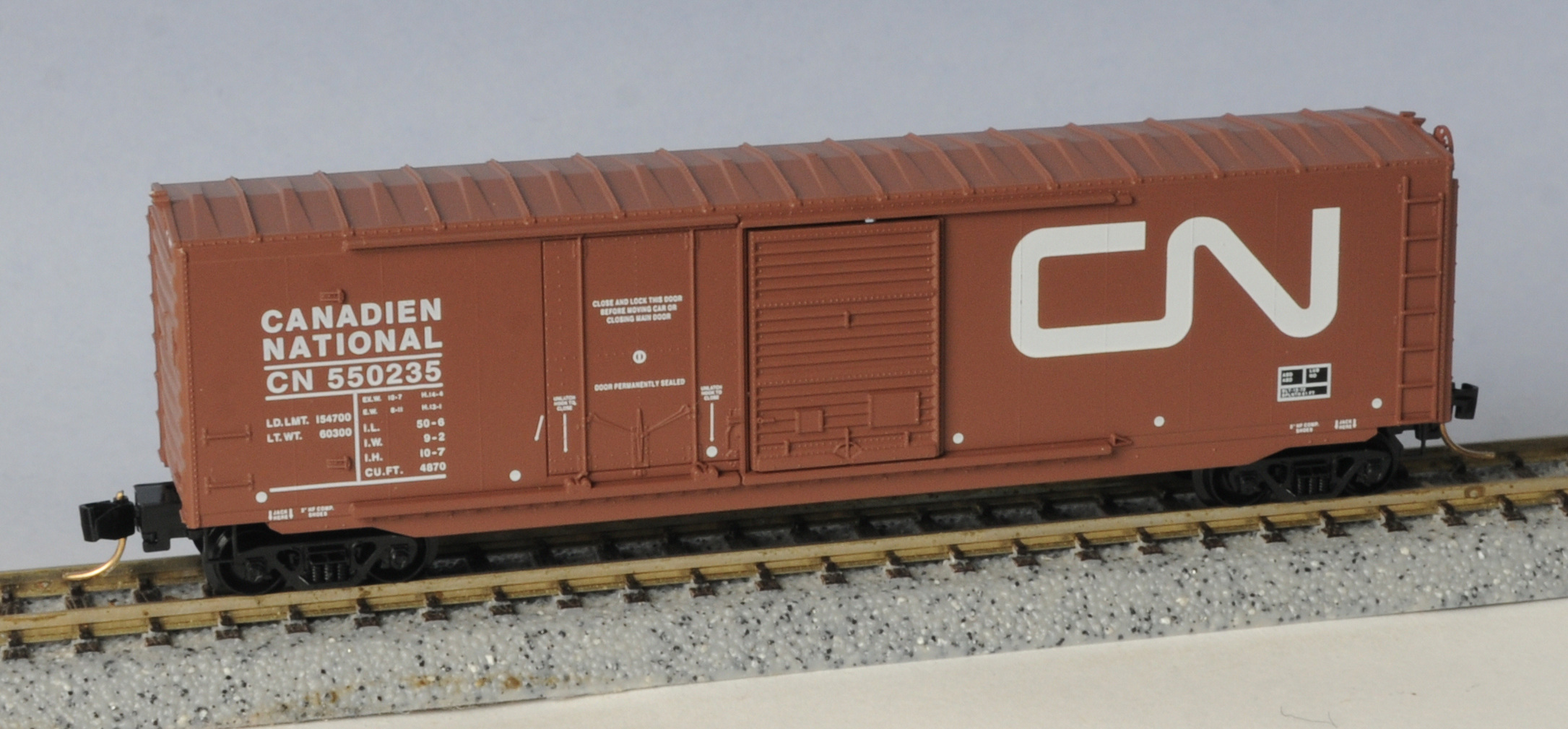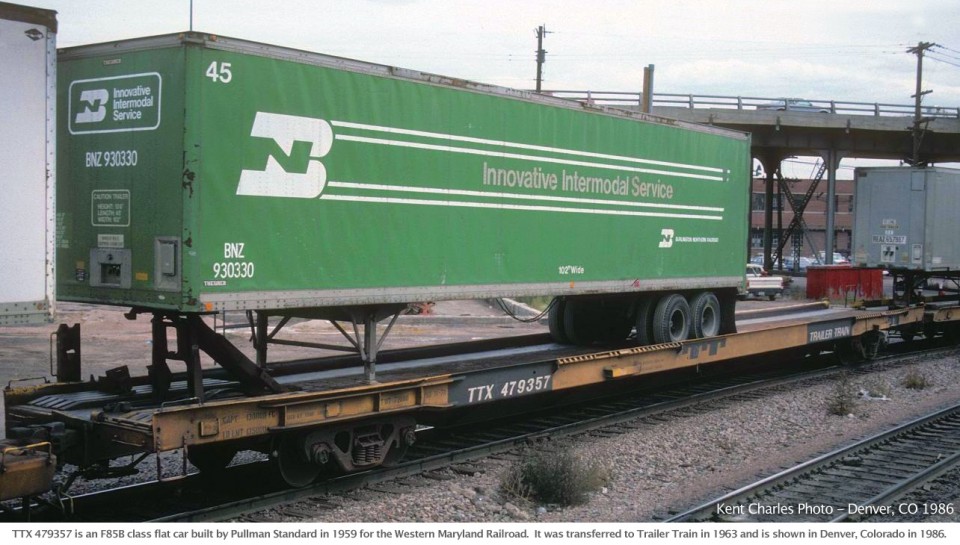Specific Item Information: AFT Release 10 - Flat Car #32 with three wagons (#15, #16, #20) and a Step Van.
Three F85C TTX (Trailer Train) flatcars were leased to haul the concessions and ticket wagons needed at each stop. The flatcars were eventually repainted and returned to the lessor.
Note that the model is based on MTL 89' flat car.
Three F85C TTX (Trailer Train) flatcars were leased to haul the concessions and ticket wagons needed at each stop. The flatcars were eventually repainted and returned to the lessor.
Note that the model is based on MTL 89' flat car.
Model Information: Each car comes with two styles of trailer hitches. The first of these prototypical hitches represents a rigid hitch in the elevated position for use when hauling trailers. The second hitch is in the closed, retracted position for use when the flatcar is running empty.
Note: the hole in the trailer hitch in elevated position is a bit tight to accommodate the trailer hook pin of the Micro-Trains Fruehauf trailer box vans; it requires to widen it slightly.
Note: the hole in the trailer hitch in elevated position is a bit tight to accommodate the trailer hook pin of the Micro-Trains Fruehauf trailer box vans; it requires to widen it slightly.
Prototype History: A flatcar (US) (also flat car (US) or flat wagon (UIC)) is a piece of railroad (US) or railway (non-US) rolling stock that consists of an open, flat deck mounted on a pair of trucks (US) or bogies (UK), one at each end containing four or six wheels. Occasionally, flat cars designed to carry extra heavy or extra large loads are mounted on a pair (or rarely, more) of bogeys under each end . The deck of the car can be wood or steel, and the sides of the deck can include pockets for stakes or tie-down points to secure loads. Flatcars designed for carrying machinery have sliding chain assemblies recessed in the deck.
Flatcars are used for loads that are too large or cumbersome to load in enclosed cars such as boxcars. They are also often used to transport intermodal containers (shipping containers) or trailers as part of intermodal freight transport shipping.
TOFC (Trailer On Flat Car, a.k.a. piggy-back) cars came is various length to accommodate usually two trailers: 50' for two 24' trailers, 75' for two 35' trailers, 85' for two 40' trailers and 89' for two 45' trailers.
The first 85’ flat was introduced by Pullman Standard in December 1958 and was followed by ACF in 1959 and Bethlehem Steel in 1960. These cars became a necessity to continue accommodate 2 trailers per car after the Congress considered the Interstate Highway Act and trailer sizes increased to 40’ in length, leading to obsolescence of the then 75' flat cars (for 2 35' trailers). The 85' flat themselves were late superseded by 89' flat in the 1980's that were designed for even longer trailers.
From Wikipedia
Read more on Model 160 N Scale Website
Flatcars are used for loads that are too large or cumbersome to load in enclosed cars such as boxcars. They are also often used to transport intermodal containers (shipping containers) or trailers as part of intermodal freight transport shipping.
TOFC (Trailer On Flat Car, a.k.a. piggy-back) cars came is various length to accommodate usually two trailers: 50' for two 24' trailers, 75' for two 35' trailers, 85' for two 40' trailers and 89' for two 45' trailers.
The first 85’ flat was introduced by Pullman Standard in December 1958 and was followed by ACF in 1959 and Bethlehem Steel in 1960. These cars became a necessity to continue accommodate 2 trailers per car after the Congress considered the Interstate Highway Act and trailer sizes increased to 40’ in length, leading to obsolescence of the then 75' flat cars (for 2 35' trailers). The 85' flat themselves were late superseded by 89' flat in the 1980's that were designed for even longer trailers.
From Wikipedia
Read more on Model 160 N Scale Website
Road Name History: The American Freedom Train (AFT) was a 26-car train led by one of three enormous steam engines restored just for the occasion. Over a 21 month period from April 1, 1975 to December 31, 1976 more than 7 million Americans visited the train during its tour of all 48 contiguous states. Tens of millions more stood trackside to see it go by. It was by far the greatest event on rails since the end of the steam era, and the uniquely magnificent vehicle that brought America's Bicentennial celebration to the people.
The first steam locomotive to pull the train was former Reading Company T-1 class 4-8-4 #2101. The second was former Southern Pacific GS-4 #4449, a large 4-8-4 steam locomotive that is still operating in special excursion service today. The third was former Texas & Pacific 2-10-4 #610, which pulled the train in Texas.
The train itself notably consisted of 10 display cars, converted from New York Central and Penn Central baggage cars. They carried more than 500 treasures of Americana (full roster on The Story of America's Freedom Trains).
Read more on Wikipedia
Read more on The Story of America's Freedom Trains.
The first steam locomotive to pull the train was former Reading Company T-1 class 4-8-4 #2101. The second was former Southern Pacific GS-4 #4449, a large 4-8-4 steam locomotive that is still operating in special excursion service today. The third was former Texas & Pacific 2-10-4 #610, which pulled the train in Texas.
The train itself notably consisted of 10 display cars, converted from New York Central and Penn Central baggage cars. They carried more than 500 treasures of Americana (full roster on The Story of America's Freedom Trains).
Read more on Wikipedia
Read more on The Story of America's Freedom Trains.
Brand/Importer Information: Micro-Trains is the brand name used by both Kadee Quality Products and Micro-Trains Line. For a history of the relationship between the brand and the two companies, please consult our Micro-Trains Collector's Guide.
Manufacturer Information:  Micro-Trains Line split off from Kadee Quality Products in 1990. Kadee Quality Products originally got involved in N-Scale by producing a scaled-down version of their successful HO Magne-Matic knuckle coupler system. This coupler was superior to the ubiquitous 'Rapido' style coupler due to two primary factors: superior realistic appearance and the ability to automatically uncouple when stopped over a magnet embedded in a section of track. The success of these couplers in N-Scale quickly translated to the production of trucks, wheels and in 1972 a release of ready-to-run box cars.
Micro-Trains Line split off from Kadee Quality Products in 1990. Kadee Quality Products originally got involved in N-Scale by producing a scaled-down version of their successful HO Magne-Matic knuckle coupler system. This coupler was superior to the ubiquitous 'Rapido' style coupler due to two primary factors: superior realistic appearance and the ability to automatically uncouple when stopped over a magnet embedded in a section of track. The success of these couplers in N-Scale quickly translated to the production of trucks, wheels and in 1972 a release of ready-to-run box cars.
Micro-Trains Line Co. split off from Kadee in 1990 to form a completely independent company. For this reason, products from this company can appear with labels from both enterprises. Due to the nature of production idiosyncrasies and various random factors, the rolling stock from Micro-Trains can have all sorts of interesting variations in both their packaging as well as the products themselves. When acquiring an MTL product it is very important to understand these important production variations that can greatly enhance (or decrease) the value of your purchase.
Please consult our Micro-Trains Collector's Guide

Micro-Trains Line Co. split off from Kadee in 1990 to form a completely independent company. For this reason, products from this company can appear with labels from both enterprises. Due to the nature of production idiosyncrasies and various random factors, the rolling stock from Micro-Trains can have all sorts of interesting variations in both their packaging as well as the products themselves. When acquiring an MTL product it is very important to understand these important production variations that can greatly enhance (or decrease) the value of your purchase.
Please consult our Micro-Trains Collector's Guide
Commissioner Information:  Desiring to bring a creative and artistic approach to model railroad cars, Lowell Smith Signature Series was born in 1994. The first special run car commemorated the Sesquicentennial (150th anniversary) of the Golden Spike - "Wedding of the Rails". Since 1994, Lowell Smith Signature Series has continued to produce over one hundred and thirty-five unique cars or train locomotives to date.
Desiring to bring a creative and artistic approach to model railroad cars, Lowell Smith Signature Series was born in 1994. The first special run car commemorated the Sesquicentennial (150th anniversary) of the Golden Spike - "Wedding of the Rails". Since 1994, Lowell Smith Signature Series has continued to produce over one hundred and thirty-five unique cars or train locomotives to date.
A native of Portland, Oregon, Lowell Smith married his church choir sweetheart Barb in 1978. After a lifetime of rail-fanning, Lowell and Barb ventured out in 1992 to launch a new business in Portland, Oregon.
Following Lowell's passion of model trains, The Hobby Smith was built to be the community center for model railroaders - operators and collectors alike. Located in the Hollywood District of Portland, The Hobby Smith was the place to learn and to enjoy the camaraderie of others with the same passion.
A native of Portland, Oregon, Lowell Smith married his church choir sweetheart Barb in 1978. After a lifetime of rail-fanning, Lowell and Barb ventured out in 1992 to launch a new business in Portland, Oregon.
Following Lowell's passion of model trains, The Hobby Smith was built to be the community center for model railroaders - operators and collectors alike. Located in the Hollywood District of Portland, The Hobby Smith was the place to learn and to enjoy the camaraderie of others with the same passion.
Item created by: Alain LM on 2018-07-30 10:24:20. Last edited by CNW400 on 2020-08-22 12:07:22
If you see errors or missing data in this entry, please feel free to log in and edit it. Anyone with a Gmail account can log in instantly.
If you see errors or missing data in this entry, please feel free to log in and edit it. Anyone with a Gmail account can log in instantly.



